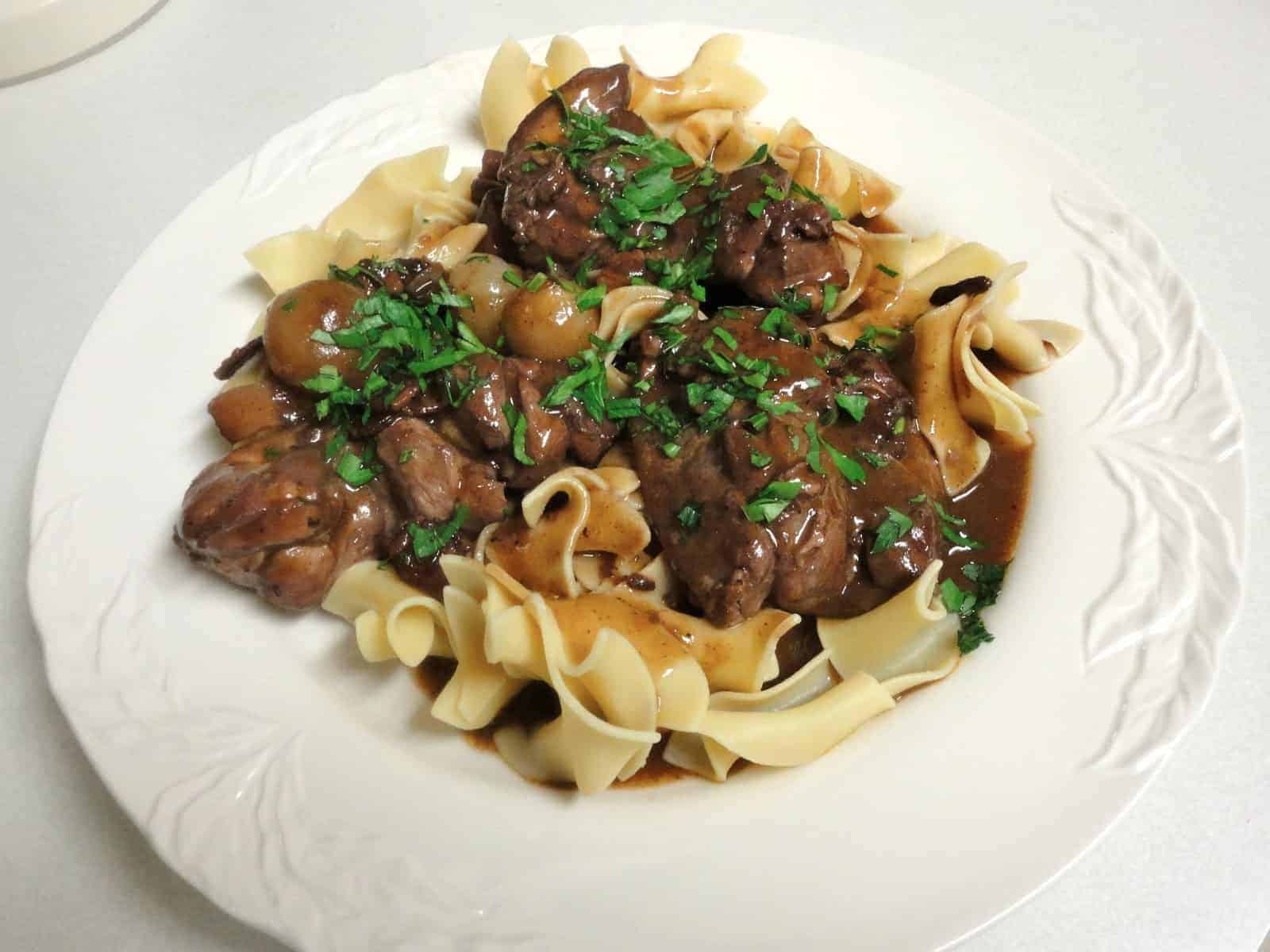Recipe for 90 Minute Coq au Vin from Cook’s Illustrated
Serves 4 to 6
1 bottle fruity, smooth, medium-bodied red wine
2 cups low-sodium chicken broth
10 sprigs fresh parsley leaves
2 tablespoons minced fresh parsley leaves
2 sprigs fresh thyme
1 bay leaf
4 ounces bacon , preferably thick-cut, cut crosswise into 1/4-inch pieces
2 1/2 pounds boneless, skinless chicken thighs , trimmed of excess fat and cut in half crosswise
Table salt and ground black pepper
5 tablespoons unsalted butter
24 frozen pearl onions , thawed, drained, and patted dry (about 1 cup)
8 ounces cremini mushrooms , wiped clean, stems trimmed, halved if small and quartered if large
2 medium cloves garlic , minced or pressed through garlic press (about 2 teaspoons)
1 tablespoon tomato paste
2 tablespoons all-purpose flour
1. Bring all but 1 tablespoon wine (reserve for later use), broth, parsley sprigs, thyme, and bay to simmer in large saucepan over medium-high heat. Cook until reduced to 3 cups, about 25 minutes. Discard herbs.
2. Meanwhile, cook bacon in large Dutch oven over medium heat until browned, 7 to 8 minutes. Using slotted spoon, transfer bacon to paper-towel-lined plate. Reserve 2 tablespoons fat in small bowl; discard remaining fat.
3. Lightly season chicken with salt and pepper. Heat 1 tablespoon reserved bacon fat in Dutch oven over medium-high heat until just smoking. Add half of chicken in single layer and cook until lightly browned, about 2 minutes per side. Transfer to plate and repeat with remaining chicken and 1 tablespoon bacon fat.
 4. Melt 3 tablespoons butter in now-empty Dutch oven over medium-high heat. When foaming subsides, add pearl onions and mushrooms; cook, stirring occasionally, until lightly browned, 5 to 8 minutes. Reduce heat to medium, add garlic, and cook until fragrant, about 30 seconds. Add tomato paste and flour; cook, stirring frequently, until well combined, about 1 minute.
4. Melt 3 tablespoons butter in now-empty Dutch oven over medium-high heat. When foaming subsides, add pearl onions and mushrooms; cook, stirring occasionally, until lightly browned, 5 to 8 minutes. Reduce heat to medium, add garlic, and cook until fragrant, about 30 seconds. Add tomato paste and flour; cook, stirring frequently, until well combined, about 1 minute.5. Add reduced wine mixture, scraping bottom of pot with wooden spoon to loosen browned bits; add 1/4 teaspoon pepper. Return chicken, any accumulated juices, and reserved bacon to pot; increase heat to high and bring to boil. Reduce heat to medium-low, cover pot, and simmer until chicken is tender, about 25 minutes, stirring halfway through cooking time.

6. Using slotted spoon, transfer chicken to large bowl; tent with foil to keep warm. Increase heat to medium-high and simmer sauce until thick and glossy and measures 3 1/4 cups, about 5 minutes. Off heat, stir in remaining 2 tablespoons butter and reserved 1 tablespoon wine. Season to taste with salt. Return chicken to pot and top with minced parsley. Serve immediately.





Yet another mouth-watering post! How do you do it?
Thanks for the addition of the exact wine you used. As a non-drinker of wine (please forgive me…)I love to cook with it but am challenged, to say the least, when it comes to buying the right wines for the right dishes. How could you beat $3.99?
Thanks, Monte.
Katie, huge fan of anything to do with Chris Kimball
Dear Katie, Once again, thank you for your kind comments. This dish is a wonderful addition to anyone's repertoire. And as to the wine, I hope you have a reasonably priced liquor store near you. There is no reason to drop a bundle on cooking wine. And Gato Negro has a whole series of Merlots, Cabernet Merlots and Chardonnay to choose from. Enjoy the dish!
We loved it. thanks for the recipe.
Thanks Lauren, for taking the time to write! We had a second round of the dish–leftover from the first–and I must say it was every bit as good. Thank you Cook's Illustrated for figuring this one out!
Can this resipe be doubled?
Thank you
I just looked over this recipe and see absolutely no reason why you could not double it. I just hope you have a pot big enough! All best and let us know how it turns out.
Can you tell me what cutting the thighs in half crosswise means?
Dear Todd, Not the best description I am afraid. Lay the cutlet on a cutting board on what would be the skinless side. Cut the cutlet in half vertically. Does that make sense?